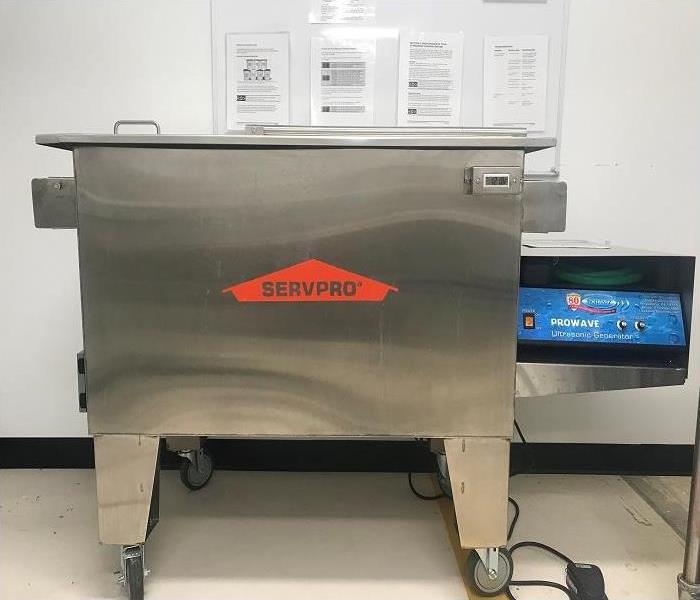What Can You Restore Using Ultrasonic Cleaning?
10/21/2019 (Permalink)
 This is the state-of-the-art Morantz Ultrasonic machine SERVPRO of East Cobb uses to clean textiles, electronics, and other items.
This is the state-of-the-art Morantz Ultrasonic machine SERVPRO of East Cobb uses to clean textiles, electronics, and other items.
When it comes to cleaning and restoring contents and textiles in commercial applications, there’s not much that can beat an ultrasonic cleaning from the pros at SERVPRO of East Cobb. You might be asking what is ultrasonic cleaning and what kinds of items can be restored or cleaned using this method? SERVPRO of East Cobb would like to address these questions and explain why ultrasonic cleaning is one of the most thorough and cost effective ways of cleaning any number of items.
Ultrasonic cleaning is a time tested tool in the restoration field and has a wide use of applications in many industries. In the machining industry ultrasonic cleaners are used to remove fine surface particles from objects as well as oil, grease, and other lubricants/chemicals used in the machining process. Along with the oil, grease and other compounds mentioned above, ultrasonic cleaning removes dirt and grime on a microscopic level. This means that even hard to reach places like corners, cracks, crevices, textured surfaces, and other areas that are otherwise inaccessible to clean using traditional cleaning methods.
Make SERVPRO of East Cobb your official ultrasonic cleaning provider today. Give us a call (770)424-0400 and we can schedule your facility for an assessment today!
Let’s go over what exactly ultrasonic cleaning is. Ultrasonic machines very in size based on their application. Some are small enough to place on a desktop and take up no more room than a toaster oven. While other systems can take up the majority of a room and can be used to clean huge items like a vehicle transmission or even airplane parts. In either case, most systems are comprised of a heated basin filled with ultrasonic cleaning solution, and an ultrasonic transducer which produces ultrasound frequencies (20-40 kHz) to agitate the cleaning solution. Items are submerged in the basin and the transducer bombards the items with ultrasonic waves, cleaning the objects in the process. Small bubbles form on the surface of the items called cavitation bubbles. These bubbles might not sound like much but these bubbles are key to the ultrasonic cleaning process. These bubbles put a tremendous amount of pressure on dirt and other contaminants clinging to the surface of the items being cleaned. In effect each bubble is a tiny explosion that both removes and washes away materials adhering to the surface of the item being cleaned.
The reason ultrasonic cleaning is so useful in many industries, including the restoration industry, is because of how thoroughly it cleans just about anything ran through the system and the cost effectiveness of the technique. The following are some of the more common items cleaned using ultrasonic cleaning devices:
- Window Blind Cleaning - Plastics, vinyls, fabric, wood, aluminum, Venetian, vertical, micro/mini blinds are all easily and quickly cleaned using ultrasonic methods as well as pleated shades, shutters, and other draperies.
- Fire, Mold, and Water Damage Restoration Projects - Knickknacks, area carpets, oriental rugs, collectibles, stuffed animals, and even toys can be restored and cleaned using ultrasonic cleaning techniques.
- Medical Device Cleaning - Due to the complex nature of medical device cleaning ultrasonic cleaning is a great choice to clean and sanitize items like tools, wheelchairs, bed frames, nursing equipment, and other medical devices.
- Electronics Cleaning - As counter intuitive as it may sound to submerge electronics in a liquid to clean them, ultrasonic cleaning does a great job with electronics such as computers, TVs, telephones, and other appliances. Just about any electronic device can be ultrasonically cleaned and in some cases is the only method of restoring certain electronic devices.
- Parts Cleaning - Automotive, airplane, boat and countless other parts can be cleaned using ultrasonic cleaning methods as well as restaurants/industrial kitchen equipment, air vents, stove filters, and HVAC filters.






 24/7 Emergency Service
24/7 Emergency Service